Thoroughly analyzing TS Inter 2nd Year Physics Model Papers and TS Inter 2nd Year Physics Question Paper March 2017 helps students identify their strengths and weaknesses.
TS Inter 2nd Year Physics Question Paper March 2017
Time: 3 Hours
Maximum Marks: 60
Section – A (10 × 2 = 20)
Note :
- Answer all questions.
- Each question carries two marks.
- All are Very Short Answer Type Questions.
Question 1.
What is the importance of Oersted’s experiment ?
Answer:
Importance of Oersted’s experiment is every current carrying conductor produces a magnetic field around it and which is perpendicular to current carrying conductor.
Question 2.
A concave mirror produces an image of a long vertical pin, placed 40 cm from the mirror, at the position of the object. Find the focal length of the mirror.
Answer:
Give u = v = 40 cm
\(\frac{1}{\mathrm{f}}\) = \(\frac{1}{υ}\) + \(\frac{1}{\mathrm{u}}\)
\(\frac{1}{\mathrm{f}}\) = \(\frac{1}{40}\) + \(\frac{1}{40}\)
\(\frac{1}{\mathrm{f}}\) = \(\frac{2}{40}\)
f = 20 cm.
Question 3.
What happens to compass needles at the Earth’s poles ?
Answer:
At the poles, earths field is exactly vertical. So, the compass needles free to rotate in a horizontal plane only, it may point out in any direction.
![]()
Question 4.
Magnetic lines form continuous closed loops. Why ?
Answer:
Magnetic lines of force always start from north pole and forming curved path, enter south pole and travel to north pole inside the magnet. Thus lines of force are forming closed loops.
Question 5.
What is meant by wattless component of the current ?
Answer:
Average power (P) Vrms(Irms sin Φ) cos \(\frac{\pi}{2}\)
The average power consumed in the circuit due to (Irms sin Φ) component of current is zero. This component of current is known as wattless current. (Irms sin Φ) is the wattless component of current.
Question 6.
Give two uses of infrared rays.
Answer:
- Infrared rays are used for producing dehydrated fruits.
- They are used in the secret writings on the ancient walls.
- They are used in green houses to keep the plants warm.
Question 7.
What is “work function” ?
Answer:
The minimum energy required to liberate an electron from photometal surface is called work function, Φ0.
Question 8.
State Heisenberg’s Uncertainty Principle.
Answer:
Uncertainity principle states that “it is impossible to measure both position (Δx) and momentum of an electron (Δp) [or any other particle] at the same time exactly”, i.e., Δx . Δp ≈ h where Δx is uncertainity in the specification of position and Δp is uncertainity in the specification of momentum.
Question 9.
What is p-type semiconductor ? What are the majority and minority charge carriers in it ?
Answer:
If a trivalent impurity is added to a tetravalent semiconductor, it is called p-type semi-conductor.
In p-type semiconductor majority charge carriers are holes and minority charge carriers are electrons.
![]()
Question 10.
Mention the basic methods of modulation.
Answer:
The basic methods of modulation are :
- Amplitude modulation (AM)
- Frequency modulation (FM)
- Phase modulation (PM)
Section – B (6 × 4 = 24)
Note :
- Answer any six of the following questions.
- Each question carries four marks.
- All are Short Answer Type Questions.
Question 11.
Why does the setting sun appear red ?
Answer:
As sunlight travels through the earths atmosphere, gets scattered by the large number of molecules present. This scattering of sun light is responsible for the colour of the sky, during sunrise and sunset etc.
The light of shorter wave length is scattered much more than light of larger wavelength. Scattering .
∝ \(\frac{1}{\lambda^4}\)
Most of blue light is scattered, hence the bluish colour of sky predominates.
At sunset (or) sunrise, sun rays must pass through a larger atmospheric distance. More of the blue colour is scattered away only red colour which is least scattered appears to come from sun. Hence it appears red.
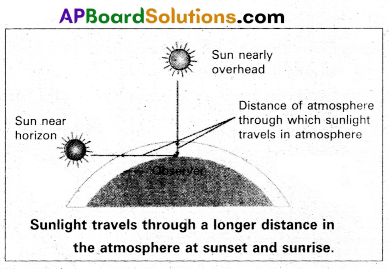
Question 12.
Discuss the intensity of transmitted light when a polaroid sheet is rotated between two crossed polaroids.
Answer:
Let I0 be the intensity of polarised light after passing through the first polariser P1. Then the intensity of light after passing through second polariser P2 will be I = I0cos2θ.
Where θ is the angle between pass axes P1 and P2. Since P1 and P2 are crossed the angle between the pass axes of P2 and P3 will be (\(\frac{\pi}{2}\) – θ)
Hence the intensity of light emerging from P3 will be
I = I0cos2 θ . cos2 (\(\frac{\pi}{2}\) – θ)
= I0 cos2 θ . sin2 θ
I = \(\frac{I_0}{4}\) sin2 2θ
∴ The transmitted intensity will be maximum when θ = \(\frac{\pi}{4}\)
Question 13.
State and explain Coulomb’s inverse square law in electricity.
Answer:
Coulomb’s law – Statement: Force between two charges is proportional to the product of the charges and inversely proportional to the square of the distance between them. The force acts along the straight line joining the two charges.
Explanation : Let us consider two charges q1 and q2 the separated by a distance r.
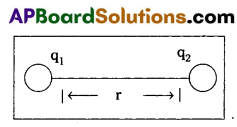
Then F α q1q2 and F ∝ \(\frac{1}{\mathrm{r}^2}\) or F ∝ \(\frac{\mathrm{q}_1 \mathrm{q}_2}{\mathrm{r}^2}\)
∴ F = \(\frac{1}{4 \pi \varepsilon_0} \cdot \frac{\mathrm{q}_1 \mathrm{q}_2}{\mathrm{r}^2}\) where \(\frac{1}{4 \pi \varepsilon_0}\) = 9 × 109 Nm2C-2
In vector form, in free space \(\overrightarrow{\mathrm{F}}\) = \(\frac{1}{4 \pi \varepsilon_0} \frac{\mathrm{q}_1 \mathrm{q}_2}{\mathrm{r}^2}\)r̂. Here r̂ is a unit vector.
ε0 is called permittivity of free space.
ε0 = 8.85 × 10-12 C2/N-m2 or Farad/meter.
In a medium, Fm = \(\frac{1}{4 \pi \varepsilon} \frac{\mathrm{q}_1 \mathrm{q}_2}{\mathrm{r}^2}\) = \(\frac{1}{4 \pi \varepsilon_0 \varepsilon_{\mathrm{r}}} \quad \frac{\mathrm{q}_1 \mathrm{q}_2}{\mathrm{r}^2}\) [∵ ε = ε0εr]
Where ε is called permittivity of the medium.
![]()
Question 14.
Explain parallel combination of capacitors. Derive the formula for equivalent capacitance in parallel combination.
Answer:
Parallel Combination: The first plates of different capacitors are connected at one terminal and all the second plates of the capacitors are connected at another terminal then the two terminals are connected to the two terminals of battery is called parallel combination.
In this combination,
1. The RD’s between each capacitor is equal (or) same.
2. Charge on each capacitor is not equal. Consider three capacitors of capacitance C1 C2 and C3 are connected in parallel across a RD ‘V’ as shown in fig.

The charge on 1st capacitor Q1 = C1 V
The charge on Ilnd capacitor Q2 = C2 V
The charge on Illrd capacitor Q3 = C3 V
∴ The total charge Q = Q1 + Q2 + Q3
= C1 V + C2 V + C3 V
Q = V(C1 + C2 + C3)
⇒ \(\frac{Q}{V}\) = C1 + C2 + C3
C = C1 + C2 + C3 [∵ C = \(\frac{Q}{V}\)]
for ‘n’ number of capacitors connected in parallel, the equivalent capacitance can be written as.
C = C1 + C2 + C3 + …. + Cn
Question 15.
State and explain Biot-Savarat Law.
Answer:
Consider a very small element of length dl of a conductor carrying current (i). Magnetic induction due to small element at a point P distance r form the element.
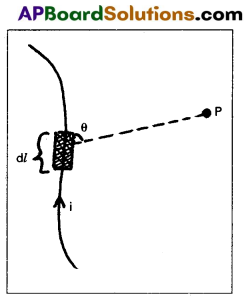
Magnetic induction (dB) is directly proportional to i) current (i) ii) Length of the element (dl) iii) sine angle between r and dl and iv) Inversely proportional to the square of the distance from small element to point P.
dB ∝ \(\frac{\mathrm{id} l \sin \theta}{\mathrm{r}^2}\)
dB = \(\frac{\mu_0}{4 \pi} \cdot \frac{\mathrm{i} d \sin \theta}{\mathrm{r}^2}\)
where μ0 = permeability in free space.
\(\frac{\mu_0}{4 \pi}\) = 10-7 Wb m-1 A-1
In vector form \(\overrightarrow{\mathrm{dB}}=\frac{\mu_0 \mathrm{i}}{4 \pi} \frac{(\overrightarrow{\mathrm{d} l} \times \overrightarrow{\mathrm{r}})}{\mathrm{r}^3}\)
Question 16.
A pair of adjacent coils has a mutual inductance of 1.5 H. If the current in one coil changes from 0 to 20 A in 0.5 sec, what is the change of flux linkage with the other coil ?
Answer:
Given M = 1.5 A
di = 20 – 0 = 20 A
dt = 0.5 sec
e = M \(\frac{\mathrm{di}}{\mathrm{dt}}\) = \(\frac{\mathrm{d} \phi}{\mathrm{dt}}\)
dΦ = M.di = 1.5 × 20
dΦ = 30 wb
Question 17.
Write a short note, on de Broglie’s explanation of Bohr’s second postulate of quantization.
Answer:
- The second postulate of Bohr atom model says that angular momentum of electron orbiting around the nucleus is quantized i.e., mυr = \(\frac{\mathrm{nh}}{2 \pi}\) where n = 1, 2, 3, ….
- According to Debroglie, the electron in its circular orbit, as proposed by Bohr, must be seen aS a particle wave.
- When a string fixed at two ends is plucked, a large number. of wavelengths are excited and standing wave is formed.
- It means that in a string, standing waves form when total distance travelled by a wave down the string and back is an integral number of wavelengths.
- According to Dehroglie, a stationary orbit-is that which contains an integral number of Debrogile waves associated with the revolving electron.
- For an electron revolving in nth circular orbit of radius rn, total distance covered = circumference of the orbit = 2πrn
∴ For permissible orbit, 2πrn = nλ. - According to Debrogile, λ = \(\frac{h}{m v_n}\)
Where υn is speed of electron revolving in nth orbit
∴ 2πrn = \(\frac{\mathrm{nh}}{\mathrm{mv} v_{\mathrm{n}}}\)
mυnrn = \(\frac{\mathrm{nh}}{2 \pi}\) = n(\(\frac{\mathrm{h}}{2 \pi}\))
i.e., angular momentum of electron revolving in nth orbit must be an integral multiple of \(\frac{\mathrm{h}}{2 \pi}\), which is the quantum condition proposed by Bohr in second postulate.
![]()
Question 18.
Define NAND and NOR gates. Give their truth tables.
Answer:
NAND gate : NAND gate is a combination of AND gate and NOT gate.

NAND gate can be obtained by connecting a NOT gate in the output of an AND gate. NAND gates are called universal gates.
i) If both inputs are low, output is high.
A = 0, B = 0, X = 1
ii) If any input is low, output is high.
A = 0, B = 1, X = 1
A = 1, B = 0, X = 1
iii) If both inputs are high, output is low.
A = 1, B = 1, X = 0
Truth table
| A | B | X = \( \overline{A . B} \) |
| 0 | 0 | 1 |
| 0 | 1 | 1 |
| 1 | 0 | 1 |
| 1 | 1 | 0 |
NOR gate : NOR gate is a combination of OR gate and NOT gate when the output of OR gate is connected to NOT gate. It has two (or) more inputs and one output.

i) If both inputs are low, output is high.
A = 0, B = 0, X = 1
Truth table
| A | B | X = \(\overline{A+B}\) |
| 0 | 0 | 1 |
| 0 | 1 | 0 |
| 1 | 0 | 0 |
| 1 | 1 | 0 |
ii) If any input is high, the output is low.
A = 0, B = 1, X = 0
A = 1, B = 0, X = 0
iii) If both inputs are high, the output is low.
A = 1, B = 1, X = 0
NOR gate is also a universal gate.
Section – C (2 × 8 = 16)
Note :
- Answer any two of the following questions.
- Each question carries eight marks.
- All are Long Answer Type Questions.
Question 19.
i) What is Doppler Effect ? Obtain an expression for the apparent frequency of sound heard, when the source is – in motion with respect to an observer at rest ?
ii) A train sounds its whistle as it approaches and crosses a level-crossing. An observer at the crossing measures a frequency of 219 Hz as the train approaches and a frequency of 184 Hz as it leaves. If the speed of sound is taken to be 340 m/s. Find the speed of the train.
Answer:
i) Doppler effect : The apparent change in the frequency heard by the observer due to the relative motion between the observer and the source of sound is called doppler effect.
When a whistling railway engine approaches an observer standing on the platform, the frequency of sound appears to increase. Wherr it moves away the frequency appear to decrease.
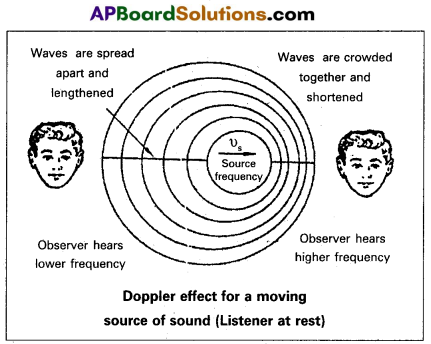
Expression for apparent frequency when source is in motion and listener at rest:
Let S = Source of sound
0 = Listener
Let ’S’ be the source, moving with a velocity ‘υs‘ towards the stationary listener.
The distance travelled by the source in time period ‘T’ = υs. T
Therefore the successive compressions and rarefactions are drawn closer to listener.
∴ Apparent wavelengt λ’ – λ = υsT.
λ’ = λ – \(\frac{υ_s}{v}\) [∵ v = \(\frac{1}{\mathrm{~T}}\)]
\(\frac{\lambda v-υ_s}{v}=\frac{v-υ_s}{v}\) [υ = vλ] (∵ υ = vλ)
If ”v” is apparent frequency heard by the listener then v’ = \(\frac{v}{\lambda^{\prime}}\), where ‘υ’ is velocity of sound in air v’ = \(\frac{υ . v}{υ-υ_s}\)
Therefore, the apparent frequency is greater than the actual frequency.
Similarly, if the source is away from the stationary listener then apparent frequency v’ = \(\frac{υ . v}{υ+υ_s}\), which is less than tlpe actual frequency.
Limitation: Doppler effect is applicable when the velocities of the source and listener are much less than that of sound velocity, ii) When a whistling train approaches to rest observer,

When a whistling train away from rest observer, ![]()

Here v’ = 219 Hz; v” = 184 Hz;
v = 340 m/s
\(\frac{(1)}{(2)}\) ⇒ \(\frac{υ^{\prime}}{υ^{\prime \prime}}=\frac{\left(υ+υ_s\right)}{\left(υ-υ_s\right)}\)
\(\frac{219}{184}\) = \(\frac{340+υ_s}{340-υ_s}\)
219(340 – υs = 184(340 + υs)
219 × 340 – 219 υs = 184 × 340 + 184 υs
403 υs = 35 × 340
∴ Velocity of train υs = 29.5 m/s
Frequency of whistle, v = v’ × \(\frac{v-v_s}{v}\)
= 219 × [latex]\frac{340-29.5}{340}[/latex] = 199.98
∴ v = 200 Hz.
![]()
Question 20.
i) State the working principle of potentiometer. Explain with the help of a circuit diagram, how the potentiometer
is used to determine the internal resistance of the given primary cell.
ii) A battery of emf 2.5 V and internal resistance ‘r’ is connected in series with a resistor of 45 Ohm through an ammeter of resistance I Ohm. The ammeter reads a current of 50 mA. Calculate the internal resistance r.
Answer:
i) Working principle of potentiometer : The potential difference across a length of the potentiometer wire is directly proportional to its length (or) when a steady current is passed through a uniform wire, potential drop per unit length or potential gradient, is constant.
i.e. ε ∝ l ⇒ ε = Φl
where Φ is potential gradient.
Measurement of internal resistance (r) with potentiometer :
- Potentiometer to measure internal resistance (r) of a cell (ε) is shown in diagram.
- The cell (emf ε) whose internal resistance (r)is to be determined is connected across a resistance box (R.B) through a key K2.
- With key K2 open, balance is obtained at length l1(AN1).
Then ε = Φ l1 ………… (1) - When key K2 is closed, the cell sends a current (I) through the resitance box (R.B).
- If V is the terminal potential difference of the cell and balance is obtained at length l2 (AN2).
ThenV = Φ l2 ………. (2)
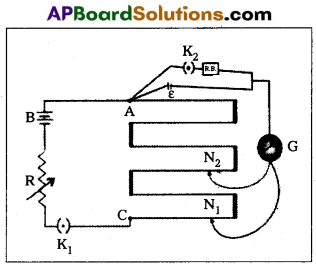
- \(\frac{(1)}{(2)}\) ⇒ \(\frac{\mathrm{e}}{\mathrm{v}}=\frac{l_1}{l_2}\) ………..(3)
- But ε = I (r + R) and V = IR. This gives
\(\frac{\varepsilon}{\mathrm{V}}\) = \(\frac{(\mathrm{r}+\mathrm{R})}{\mathrm{R}}\)
\(\frac{l_1}{l_2}\) = (\(\frac{r}{R}\) + 1) [∵ from (3)]
∴ r = R(\(\frac{l_1}{l_2}\) – 1)
ii) Circuit diagram for the given data is shown below.
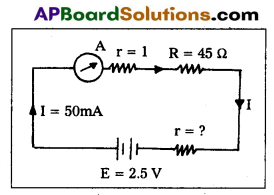
Given,
E = 2.5 V
R = 45 Ω;
rA = 1A
I = 50mA
r = ?
E = I (R + rA + r)
2.5 = 50 × 10-3 (45 + 1 + r)
46 + r = \(\frac{2.5}{50 \times 10^{-3}}\) = \(\frac{2.5 \times 10^3}{50}\) = 50
∴ r = 50 – 46 = 4Ω.
![]()
Question 21.
Explain the principle and working of a nuclear reactor with the help of a labelled diagram.
Answer:
Principle : A nuclear reactor works pn the principle of achieving controlled chain reaction in natural Uranium 238U enriched with 235U, consequently generating large amounts of heat.
A nuclear reactor consists of
1) Fuel
2) Moderator
3) Control rods
4) Radiation shielding
5) Coolant.

1. Fuel and clad : In reactor the nuclear fuel is fabricated in the form of thin and long cylindrical rods. These group of rods treated as a fuel assembly. These rods are surrounded by coolant, which is used to transfer of heat produced in them. A part of the nuclear reactor which use to store the nuclear fuel is called the core of the reactor. Natural uranium, enriched uranium, plutonium and uranium – 233 are used as nuclear fuels.
2. Moderator : The average energy of neutrons released in fission process is 2 MeV They are used to slow down the velocity of neutrons. Heavy water or graphite are used as moderating materials in reactor.
3. Control Rods : These are used to control the fission rate in reactor by absorbing the neutrons. Cadmium and boron are used as controlling the neutrons, in the form of rods.
4. Shielding : During fission reaction beta and gamma rays are emitted in addition to neutrons. Suitable shielding such as steel, lead,’ concrete etc are provided around the reactor to absorb and reduce the intensity of radiations to such low levels that do not harm the operating personnel.
5. Coolant: The heat generated in fuel elements is removed by using a suitable coolant to flow around them. The coolants used are water at high pressures, molten sodium etc.
Working : Uranium fuel rods are placed in the aluminium cylinders. The graphite moderator is placed in between the fuel cylinders. To control the number of neutrons, a number of control rods of cadmium or beryllium or boron are placed in the holes of graphite block. When a few 235U nuclei undergo fission fast neutrons are liberated. These neutrons pass through the surrounding graphite moderator and loose their energy to become thermal neutrons. These thermal neutrons are captured by 235U. The heat generated here is used for heating suitable coolants which in turn heat water and produce steam. This steam is made to rotate steam turbine and there by drive a generator of production for electric power.